Canon XSi: 12.2 Megapixels, Image Stabilized Lens, and Double Live View
by Wesley Fink on May 5, 2008 3:00 AM EST- Posted in
- Digital Camera
XSi compared to XTi
As the top-selling model in the DSLR universe, each new Canon builds on the previous model's footprint and features. This evolutionary approach keeps new Rebels familiar, but Canon also has managed to keep their entry flagship fresh with the latest must-have features and new Canon innovations.
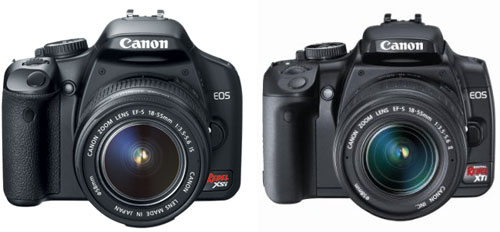
The XSi is more rounded and less angular than the XTi. It is also slightly larger than the XTi to accommodate the larger 3" LCD.
| Canon XSi vs. Canon XTi | ||
| XSi | XTi | |
| Dimensions | 129 x 97.5 x 61.9mm 5.1 x 3.8 x 2.4" |
126.5 x 94.2 x 65mm 5.0 x 3.7 x 2.6" |
| Weight | 475g (16.8oz) - Body only 525g (18.5oz) - with Battery |
510g (18oz) - Body Only 556g (19.6oz) |
The XSi is 2.5mm wider and 3.3mm taller than the XTi. However, it is 3.1mm less deep and 35g lighter than the current XTi. The overall impression is the XSi is slightly larger than the XTi, and it is surprisingly light. The rubber grip cover is now more "texturized" with subtle changes to the shutter release depression and angle. The grip is more comfortable to hold for larger hands (still improved by adding the grip), but it is a good fit for smaller hands.
Build quality seems a cut above earlier Rebels and the appearance is definitely classier and more in keeping with the rest of the Canon DSLR line. The XSi has been described as looking like a mini 40D and that is an apt description. The XSi is also the most rugged Digital Rebel ever built with a stainless-steel chassis and a glass-reinforced engineering plastics body.
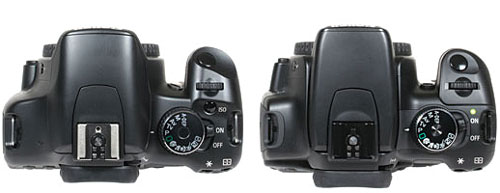
The XTi ON LED is gone, something that may matter to some users. If you look closely you can see that the shallower XSi is entirely due to the stubbier pentamirror/flash housing, which does not overhang as much as in the XTi.
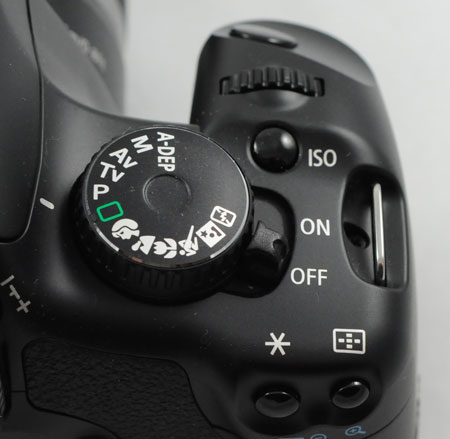
The XSi adds an ISO button just above the on-off switch. ISO is also now displayed in the viewfinder (finally!).
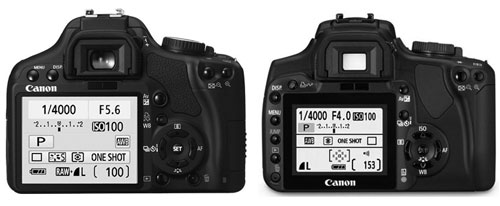
The biggest changes in the XSi are on the back where the new 3" LCD looks absolutely massive compared to the XTi's 2.5" screen. The 3" screen is the same size and specifications as the Canon 40D screen. It is also the largest screen in its class - the Nikon D60 and Olympus 510/420 are 2.5", while the Sony A350/300/200 and Pentax K200D are 2.7".
The larger screen on the XSi required a complete rearrangement of rear buttons as well. There are no longer buttons on the left and the Menu and Display buttons are now at the top left of the screen.
The right side control buttons and layout are basically the same as the XTi, with the addition of the playback and delete (trash) buttons at the bottom right of the screen. The drive/timer button has been reassigned to a directional pad button and the old button is now assigned to White Balance. In a quick glance at the XSi rear you would think it has been simplified, as it looks as if there are fewer buttons. However, all the buttons and functions are still there; they are just rearranged.

The XSi is the first Canon camera to use SD cards, a break with all previous Digital Rebels that used Compact Flash cards. This is really not a handicap at all since SD cards are now priced about the same as Compact Flash. The latest Class 6 SDHC cards are also very fast, just like the high-speed CF cards. All test shots with the XSi used a 16GB Class 6 SDHC card for image storage. The operation was trouble free and very fast.

XSi introduces a new battery that is incompatible with past models. The electrical contacts are contained in the bump on the battery - presumably to prevent accidental contact and discharge in the camera bag. The new LP-E5 (50g) rechargeable battery weighs about the same as the NB-2LH (46g) which powered the XT and XTi models. However, battery output increases about 50% to 1080 mAh compared to the 720 mAh of the NB-2LH. Battery life was not an issue with the XTi as Canon CMOS sensors are justly famous for low power consumption. The XSi battery life is even better, with plenty of reserve for driving the 3" LCD and Live View.
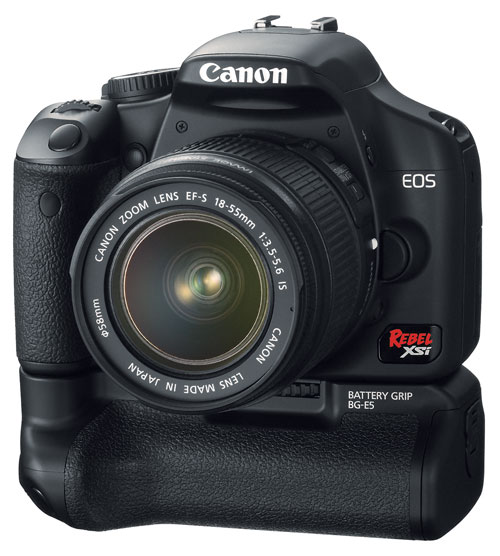
With the new LP-E5 battery also comes a new battery grip called the BP-E5. Then new BP-E5 works only on the XSi; it is incompatible with the earlier Digital Rebel grip. The earlier BP-E3 will not work on the XSi.
The new BP-E5 requires the battery cover be removed for mounting. The grip has a place to store the battery cover on the grip so it is not lost. Power for the grip is either one or two LP-E5 batteries. The grip also comes with an AA battery holder for six AA-size batteries as an alternate power source. We tested the grip with high-capacity rechargeable AA batteries and they worked fine as a power source.
It is definitely worth mentioning that the grip with two BP-E5 batteries is still extremely light, but the two dedicated batteries pack a wallop with 2160 mAh available. Unlike the Sony proprietary batteries, the new LP-E5 batteries are already available OEM from third party vendors.
An added feature of the BP-E5 is that it does provide some weather sealing, unlike the previous Digital Rebel grip. While Canon does not make a big deal of the feature, the XSi does provide some weather sealing, which is more a prosumer model feature.










56 Comments
View All Comments
AtaStrumf - Monday, May 5, 2008 - link
The last table I believe is a comparison of the XSi and the Sony A350 not:ISO Comparison - Canon XSi vs. Nikon D60
As the name of the table suggests.
Wesley Fink - Monday, May 5, 2008 - link
The table has been corrected.viqarqadir2 - Monday, May 5, 2008 - link
The first digital rebel had a 5.3 (5.1 effective) CMOS sensor and not the 6.3 you mentioned.Roy2001 - Monday, May 5, 2008 - link
Do you have a Rebel? Stop misleading!viqarqadir2 - Tuesday, May 6, 2008 - link
Yes I do have a digital rebel. Its been put away for a while now so I seem to have forgotten the pixel count on it. It does indeed have a 6.5 Mp sensor. I dont know how I got it into my mind that it has a 5.3 MP sensor but I have believed that for years now :)Sorry about the mistake
Wesley Fink - Monday, May 5, 2008 - link
According to Canon the original Digital Rebel had 6.3 effective megapixels (6.5 total megapixels) as detailed in our tables. These specifications are still available on their website.